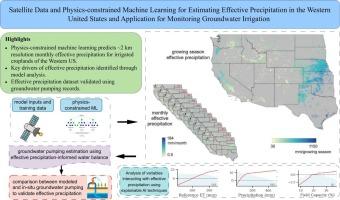估算美国西部有效降水的卫星数据和物理约束的机器学习以及监测地下水灌溉的应用
IF 6.5
1区 农林科学
Q1 AGRONOMY
引用次数: 0
摘要
有效降水,即降水产生的蒸散量,是农业水分平衡的重要组成部分,影响灌溉需水量。由于水文的复杂性,使用现有的经验和基于过程的方法来量化和验证有效降水是具有挑战性的。此外,尽管美国的高分辨率有效降水数据集在确定灌溉用水量方面很重要,但目前还没有现成的美国降水数据集。在这里,我们开发了一个框架,该框架在机器学习方法中结合了多种水文状态和通量,可以准确预测2000年至2020年美国西部灌溉农田在~ 2 公里空间分辨率和月尺度下的有效降水。通过分析影响有效降水的因素,了解灌溉景观有效降水的动态变化。为了进一步评估有效降水估算值,我们使用包含模型生成的有效降水的水平衡模型估算了美国西部七个流域的灌溉地下水抽水。将我们估计的抽水量与现场记录进行比较,结果表明技术水平良好,R2为0.78,PBIAS为-15 %。尽管在预测和评估有效降水方面仍然存在挑战,但我们的方法的令人满意的性能说明了将卫星数据和机器学习与基于物理的水平衡相结合以估计关键水通量的应用和潜力。本研究开发的有效降水数据集有潜力与基于卫星的实际蒸散发数据一起用于估算大时空尺度上的灌溉用水量,并实现最佳的科学用水管理决策。本文章由计算机程序翻译,如有差异,请以英文原文为准。

Satellite data and physics-constrained machine learning for estimating effective precipitation in the Western United States and application for monitoring groundwater irrigation
Effective precipitation, the portion of evapotranspiration derived from precipitation, is an important part of the agricultural water balance and affects the amount of water required for irrigation. Due to hydrologic complexity, effective precipitation is challenging to quantify and validate using existing empirical and process-based methods. Moreover, there is no readily available high-resolution effective precipitation dataset for the United States (US), despite its importance in determining consumptive use of irrigation water. Here, we developed a framework that incorporates multiple hydrologic states and fluxes within a machine learning approach that accurately predicts effective precipitation for irrigated croplands of the Western US at ∼2 km spatial resolution and monthly scale from 2000 to 2020. We analyzed the factors influencing effective precipitation to understand its dynamics in irrigated landscapes. To further assess effective precipitation estimates, we estimated groundwater pumping for irrigation in seven basins of the Western US with a water balance model incorporating model-generated effective precipitation. A comparison of our estimated pumping volumes with in-situ records indicates good skill, with R2 of 0.78 and PBIAS of –15 %. Though challenges remain in predicting and assessing effective precipitation, the satisfactory performance of our approach illustrate the application and potential of integrating satellite data and machine learning with a physically-based water balance to estimate key water fluxes. The effective precipitation dataset developed in this study has the potential to be used with satellite-based actual evapotranspiration data for estimating consumptive use of irrigation water at large spatio-temporal scales and enable the best available science-informed water management decisions.
求助全文
通过发布文献求助,成功后即可免费获取论文全文。
去求助
来源期刊

Agricultural Water Management
农林科学-农艺学
CiteScore
12.10
自引率
14.90%
发文量
648
审稿时长
4.9 months
期刊介绍:
Agricultural Water Management publishes papers of international significance relating to the science, economics, and policy of agricultural water management. In all cases, manuscripts must address implications and provide insight regarding agricultural water management.
 求助内容:
求助内容: 应助结果提醒方式:
应助结果提醒方式:


